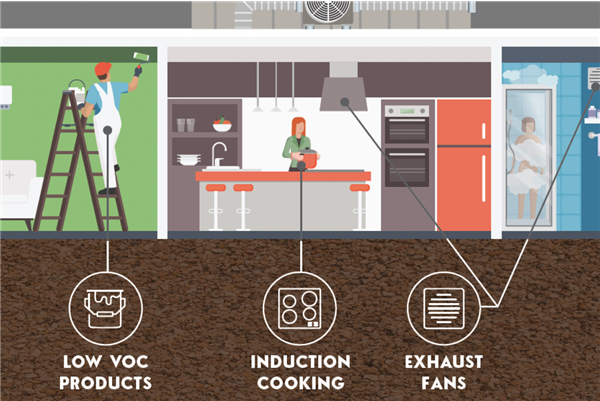Indoor Air Quality

Indoor Air Quality (IAQ) refers to the air quality in buildings as it relates to the health of the building occupants. There are many sources of indoor air pollution including combustion appliances, moisture, cleaning products, building materials, furniture, dust, pests, pollen, and outdoor air pollution including wildfire smoke. Inadequate ventilation can increase indoor pollutant levels by not bringing in enough fresh outdoor air to dilute emissions from indoor and outdoor sources and by not carrying indoor air pollutants out of the home. Improving indoor air quality can be achieved through:
SOURCE CONTROL
Eliminate individual sources of pollution or reduce their emissions.
IMPROVED VENTILATION
Install mechanical ventilation to lower the concentrations of indoor air
pollutants in your home. Mechanical Ventilation is the process of actively
supplying fresh air to and removing stale air from inside the house using
powered equipment, such as motor-driven fans and blowers.
• Air sealing. Prevents outdoor pollution from entering the home and reduces noise from outside.
• Duct sealing. Prevents pollutants from the attic or crawlspace from entering the home.
• Electric heat pumps. Eliminate combustion gas pollutants by replacing combustion appliances used for water heating, home heating systems and clothes dryers with high efficiency electric heat pumps.
• Induction cooking. Replace gas stoves with induction to eliminate combustion gas pollutants from cooking.
• Low VOC products. Choose paints, coatings, cleaning products, and furnishings with low or zero VOC (volatile organic compound) levels.
• HVAC filters. Upgrade to higher quality air filters and choose a filter with at least a MERV 13 rating, or as high a rating as your system fan and filter slot can accommodate. Replace filters regularly according to manufacturer’s recommendations.
• Portable air cleaners. Choose ENERGY STAR® HEPA air cleaners.
• Local exhaust fans. Install ENERGY STAR® kitchen and bathroom exhaust fans to remove moisture and pollutants at their source.
• Whole-house ventilation. There are two common types of mechanical whole house ventilation systems:
» Exhaust ventilation systems pull stale air out of the home and cause fresh air to come into the home through air leaks and are relatively inexpensive and easy to install.
» Balanced ventilation systems do the best job of controlling pollutants in the home by exhausting stale air and providing fresh air using both supply and exhaust fans through a filtered, ducted distribution system.